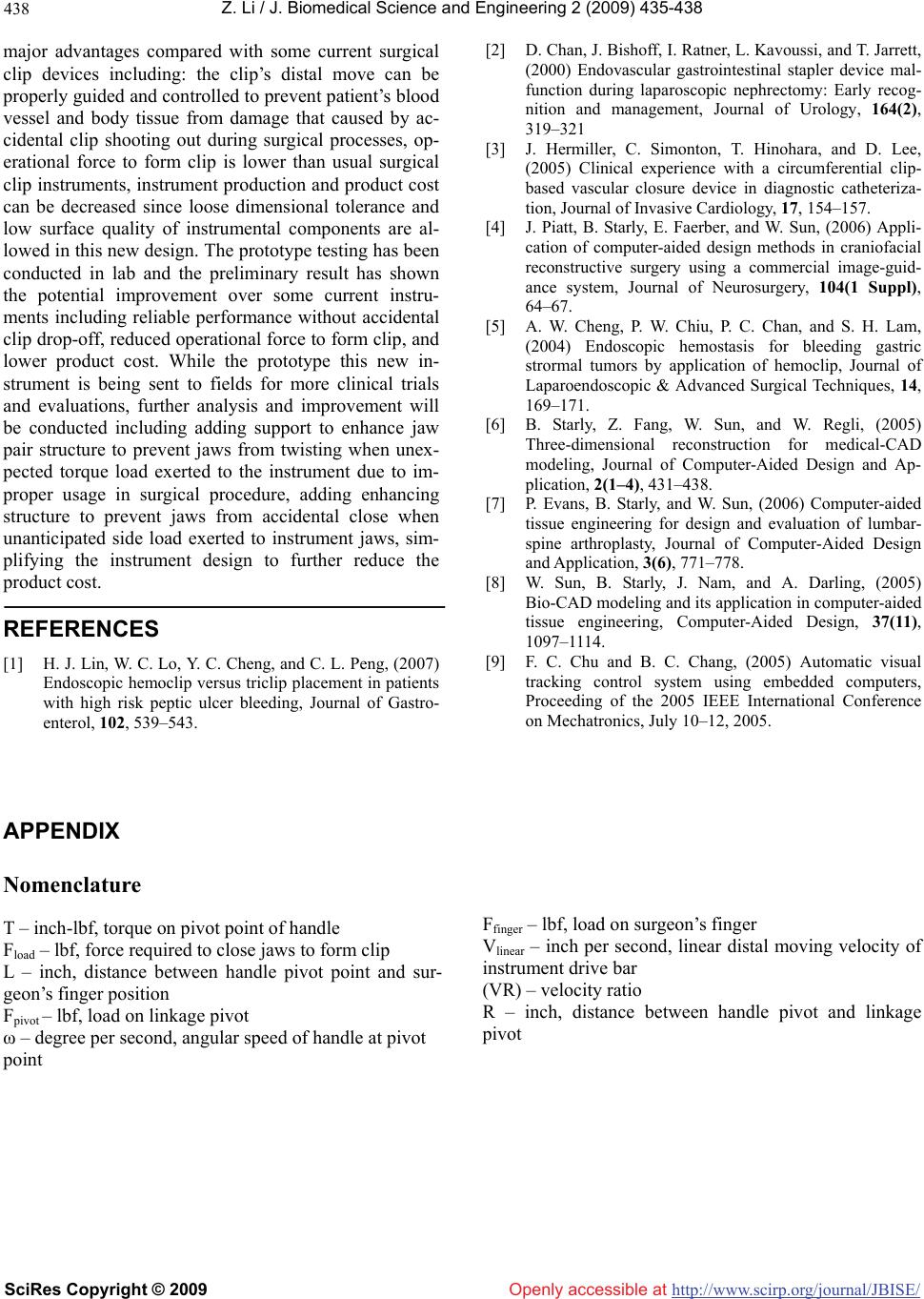
Z. Li / J. Biomedical Science and Engineering 2 (2009) 435-438
SciRes Copyright © 2009 http://www.scirp.org/journal/JBISE/
438
[2] D. Chan, J. Bishoff, I. Ratner, L. Kavoussi, and T. Jarrett,
(2000) Endovascular gastrointestinal stapler device mal-
function during laparoscopic nephrectomy: Early recog-
nition and management, Journal of Urology, 164(2),
319–321
major advantages compared with some current surgical
clip devices including: the clip’s distal move can be
properly guided and controlled to prevent patient’s blood
vessel and body tissue from damage that caused by ac-
cidental clip shooting out during surgical processes, op-
erational force to form clip is lower than usual surgical
clip instruments, instrument production and product cost
can be decreased since loose dimensional tolerance and
low surface quality of instrumental components are al-
lowed in this new design. The prototype testing has been
conducted in lab and the preliminary result has shown
the potential improvement over some current instru-
ments including reliable performance without accidental
clip drop-off, reduced operational force to form clip, and
lower product cost. While the prototype this new in-
strument is being sent to fields for more clinical trials
and evaluations, further analysis and improvement will
be conducted including adding support to enhance jaw
pair structure to prevent jaws from twisting when unex-
pected torque load exerted to the instrument due to im-
proper usage in surgical procedure, adding enhancing
structure to prevent jaws from accidental close when
unanticipated side load exerted to instrument jaws, sim-
plifying the instrument design to further reduce the
product cost.
[3] J. Hermiller, C. Simonton, T. Hinohara, and D. Lee,
(2005) Clinical experience with a circumferential clip-
based vascular closure device in diagnostic catheteriza-
tion, Journal of Invasive Cardiology, 17, 154–157.
[4] J. Piatt, B. Starly, E. Faerber, and W. Sun, (2006) Appli-
cation of computer-aided design methods in craniofacial
reconstructive surgery using a commercial image-guid-
ance system, Journal of Neurosurgery, 104(1 Suppl),
64–67.
[5] A. W. Cheng, P. W. Chiu, P. C. Chan, and S. H. Lam,
(2004) Endoscopic hemostasis for bleeding gastric
strormal tumors by application of hemoclip, Journal of
Laparoendoscopic & Advanced Surgical Techniques, 14,
169–171.
[6] B. Starly, Z. Fang, W. Sun, and W. Regli, (2005)
Three-dimensional reconstruction for medical-CAD
modeling, Journal of Computer-Aided Design and Ap-
plication, 2(1–4), 431–438.
[7] P. Evans, B. Starly, and W. Sun, (2006) Computer-aided
tissue engineering for design and evaluation of lumbar-
spine arthroplasty, Journal of Computer-Aided Design
and Application, 3(6), 771–778.
[8] W. Sun, B. Starly, J. Nam, and A. Darling, (2005)
Bio-CAD modeling and its application in computer-aided
tissue engineering, Computer-Aided Design, 37(11),
1097–1114.
REFERENCES
[9] F. C. Chu and B. C. Chang, (2005) Automatic visual
tracking control system using embedded computers,
Proceeding of the 2005 IEEE International Conference
on Mechatronics, July 10–12, 2005.
[1] H. J. Lin, W. C. Lo, Y. C. Cheng, and C. L. Peng, (2007)
Endoscopic hemoclip versus triclip placement in patients
with high risk peptic ulcer bleeding, Journal of Gastro-
enterol, 102, 539–543.
Openly accessible at
APPENDIX
Nomenclature
Ffinger – lbf, load on surgeon’s finger
T – inch-lbf, torque on pivot point of handle
Vlinear – inch per second, linear distal moving velocity of
instrument drive bar
Fload – lbf, force required to close jaws to form clip
L – inch, distance between handle pivot point and sur-
geon’s finger position (VR) – velocity ratio
R – inch, distance between handle pivot and linkage
pivot
Fpivot – lbf, load on linkage pivot
ω – degree per second, angular speed of handle at pivot
point